FOOT AND MOUTH FENCE
Botswana scrambles to erect animal disease barrier on SA border – with no sign of EIA studies
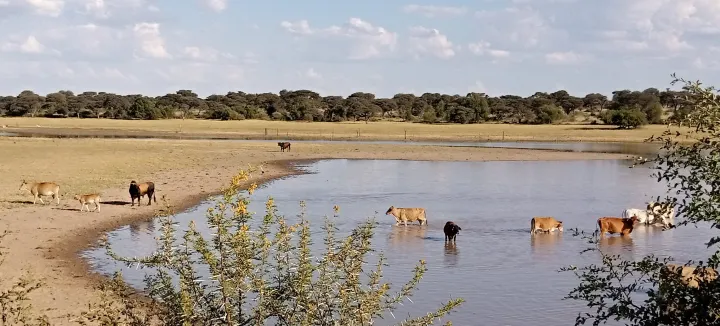
The Botswana government is erecting a fence to prevent the spread of foot and mouth disease from South Africa, but there’s concern over the potential environmental impacts of the project, specifically the loss of riverine vegetation, soil erosion and the subsequent siltation of the Molopo River.
Spooked by the spread of foot and mouth disease (FMD) into six of South Africa’s nine provinces, Botswana is erecting a new veterinary control fence along its southern border to safeguard its lucrative beef export trade to Europe.
Neither the Botswana government nor the South African agriculture department has responded to questions from Daily Maverick about the plan, but it is understood that the initial project involves erecting a 100km double cordon fence from Ramatlabama to Mabule.
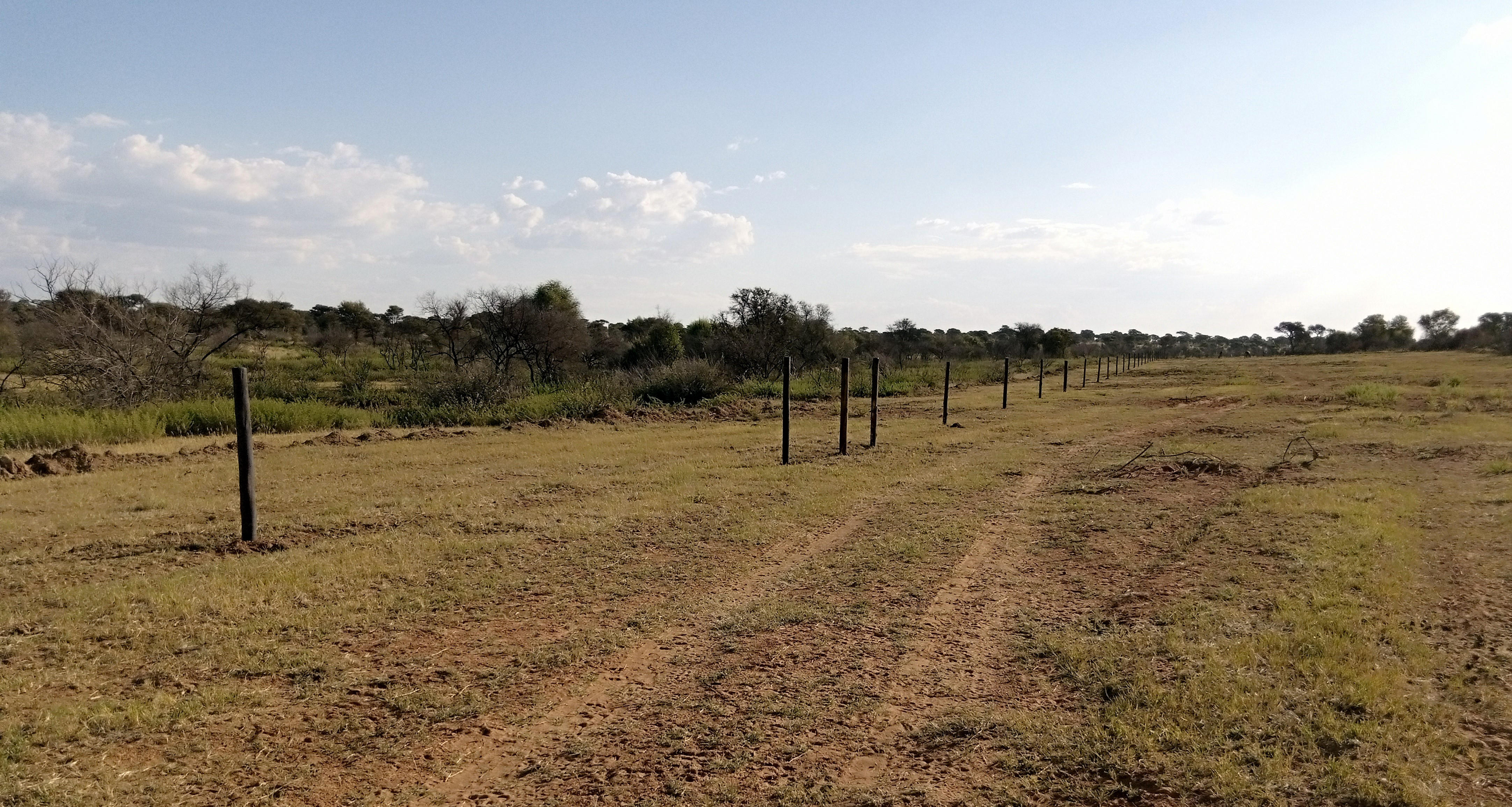
Some of the poles so far erected along a new 30m-wide cutline along the Botswana border. (Photo: Supplied)
Residents report that heavy earthmovers started clearing a new cordon along the Molopo River late in December. This included the felling of many large trees and other areas of sensitive riverine vegetation.
When villagers asked questions, they were told that the new FMD fencing project would require a 100km fence as well as clearance of a 30m-wide corridor of land between the two countries.
Further evidence of the plan to push ahead with the new barrier emerged last month when the Botswana Ministry of Agriculture posted an alert on its Facebook page, confirming that the government was “considering erecting a cordon fence along the 2,000km border between Botswana and South Africa to guard against trans-boundary animal diseases like Foot and Mouth”.
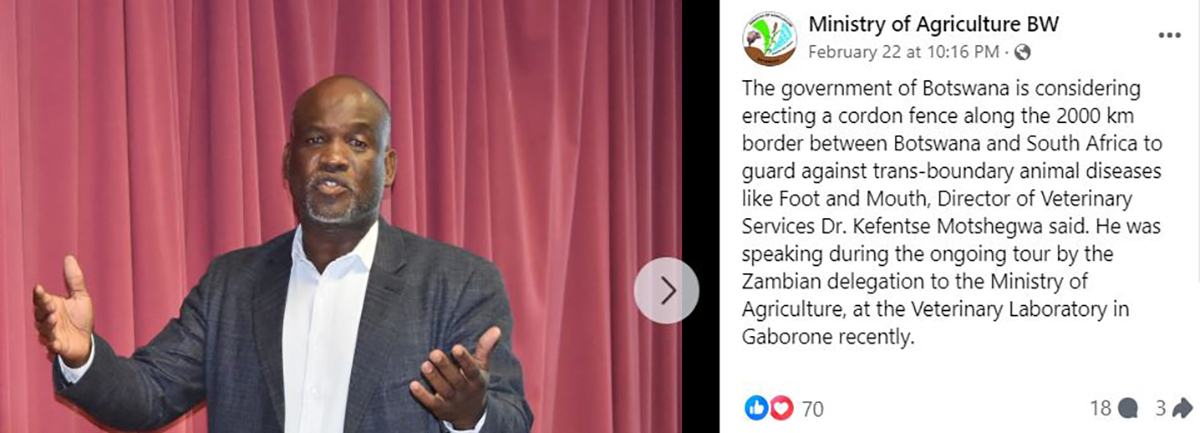
Dr Kefentse Motshegwa, the Botswana Director of Veterinary Services, confirms plans to ‘consider’ building a new disease control fence. (Source: Botswana Ministry of Agriculture Facebook page)
FMD is a highly contagious viral disease that affects cattle, pigs, sheep and goats, as well as buffalo and some other wildlife species. Outbreaks can lead to trade restrictions on the export or movement of meat and animals to Europe and other markets.
While the first sections of FMD fences on the southern Botswana border appear to be located on communal farming land, the historic erection of veterinary fences in the northern and eastern parts of the country has generated controversy after critical wildlife migration routes were blocked.
Recent amendments to Botswana’s laws require mandatory environmental impact assessment (EIA) studies for any veterinary disease control fences longer than 20km, with an assessment of the environmental impacts of all projects that could have transboundary impacts, including fencing projects longer than 15km.
However, there is no evidence that such studies have been commissioned or advertised.
It also remains unclear whether the government has granted any waivers to the legal requirements or whether the Agriculture Ministry is splitting up the new fencing projects into smaller sections to circumvent the country’s EIA regulations.
Environmental impacts
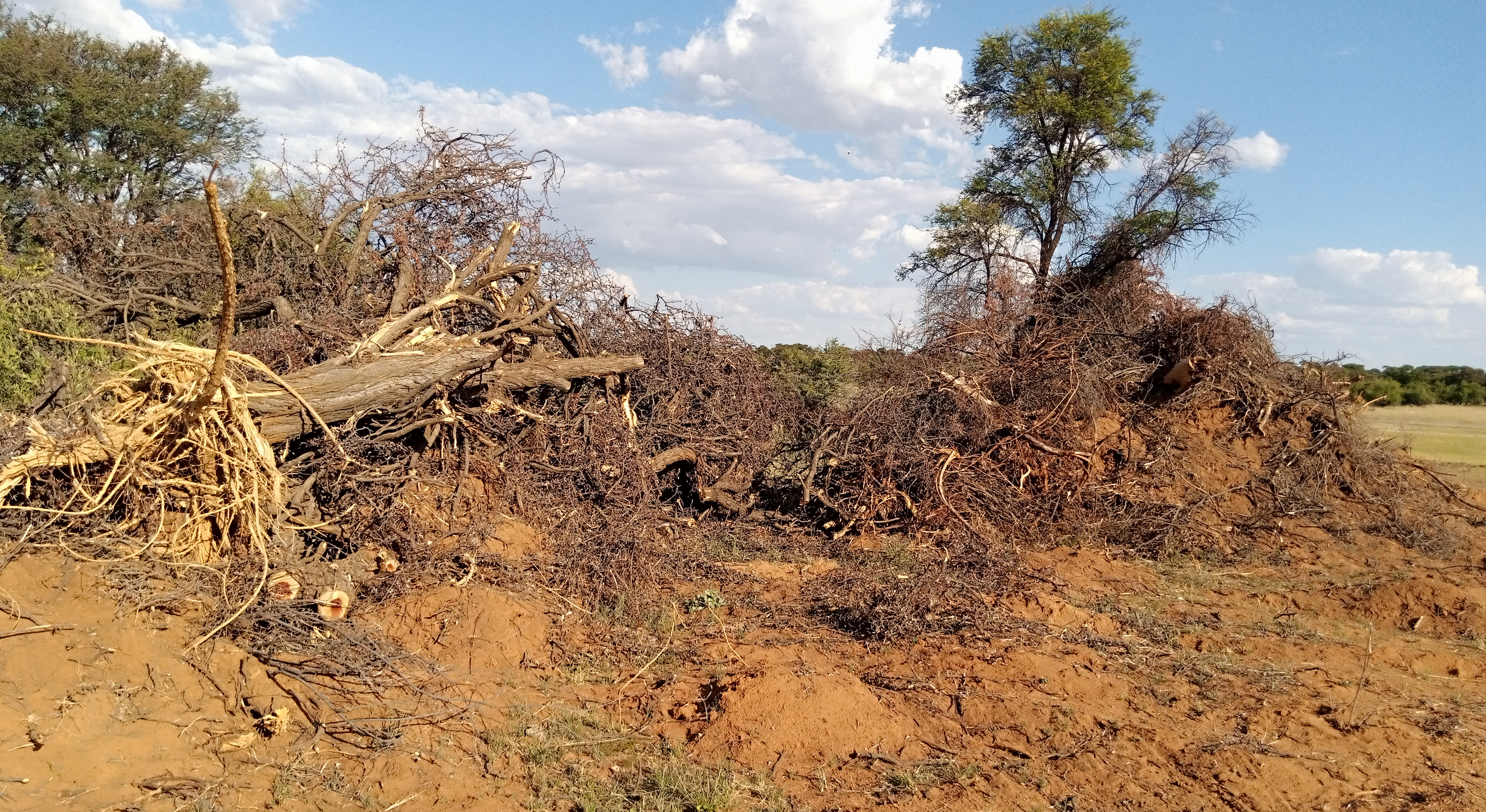
Some of the large trees and riverine vegetation flattened to make way for a new animal disease barrier along the boundary between Botswana and South Africa. (Photo: Supplied)
Leonard Dikobe, a Gaborone-based natural resources and development consultant, has written to several government departments in Botswana and South Africa expressing concern about the project but has received very few answers so far.
Dikobe, who also chairs the Dikgatlho Community Conservation Trust, said: “I understand the importance of safeguarding public health and preventing the spread of diseases such as Foot and Mouth, but it is equally crucial to ensure that these measures are implemented in an environmentally responsible and internationally collaborative manner.”
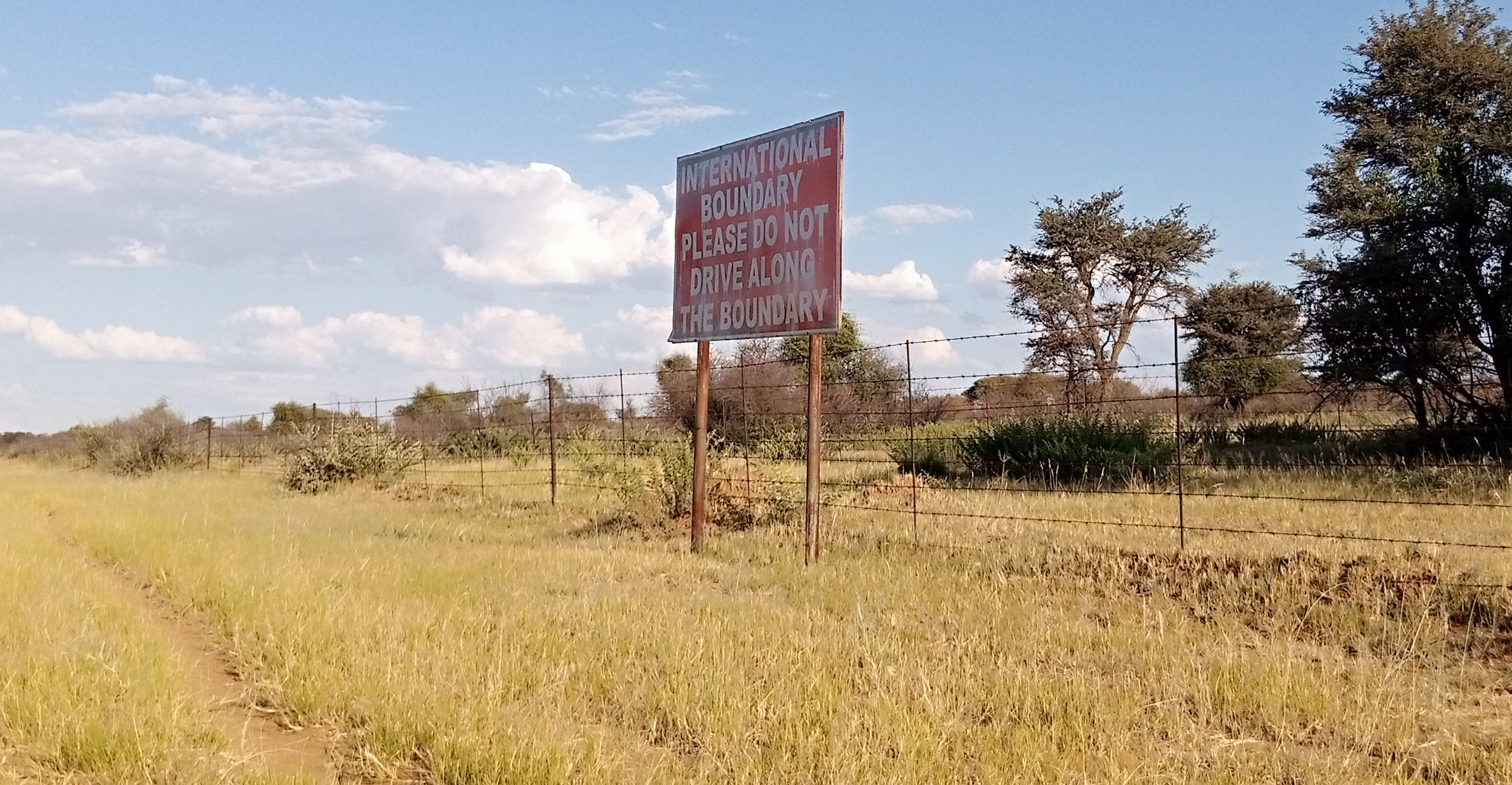
In addition to this existing barbed wire fence along the South African side of the border, Botswana has begun clearing a new veterinary cordon to control the spread of Foot and Mouth disease. (Photo: Supplied)
Noting that there is already a barbed wire fence between the two countries, he said rural residents stood to lose access to vital natural resources integral to their livelihoods due to the erection of an additional cordon on the Botswana side of the international boundary.
Dikobe said he was worried about the potential environmental impacts of the project, specifically the loss of riverine vegetation, soil erosion and the subsequent siltation of the Molopo River, which was regarded as a shared resource under the SADC Protocol on Shared Watercourses.
In a letter published in a Botswana newspaper, he suggested that there would be significant social impacts and disruptions for rural villagers around Thlareseleele, Ramatlabama, Borobadilepe, Phihetswane, Ditlharapeng, Mokatako, Phitshane, Dikhukhung, Leporung, Tshidilamolomo and Mabule.
“The consequences of this project extend far beyond mere inconvenience; they encompass the loss of access to river water, firewood, wild fruits, medicinal plants, cultural and religious sites, dams, hand-dug wells and dry-season grazing – a cornerstone of their existence.”
He raised the example of an elderly neighbour in his home village of Mokatako, who would now be compelled to walk her livestock almost 5km daily to access the nearest watering point since access to the Molopo River was being closed off.
“The stated rationale behind this project – protecting Botswana’s access to the European Union beef market – bears a bitter irony. While ostensibly driven by economic considerations, the true cost is borne by the very communities it purports to benefit,” he said.
“Why the rush to construct a new fence in the face of a perceived emergency, while neglecting existing infrastructure that could serve the same purpose? Does the urgency of the situation justify circumventing established protocols and sacrificing the wellbeing of communities?” he asked.
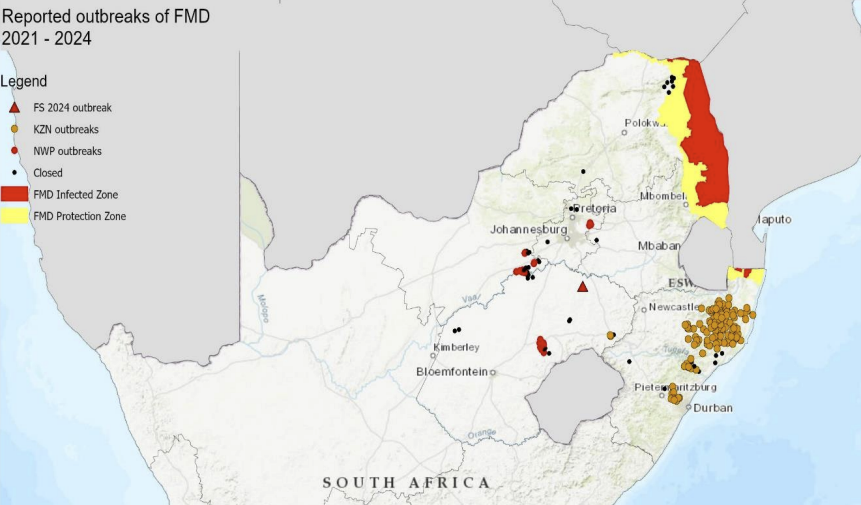
Suspected and confirmed FMD outbreaks in South Africa from 2021 to 2024. (Source Directorate of Animal Health)
The Botswana government’s apparent determination to push ahead with the new fence follows a series of FMD outbreaks in neighbouring South Africa over the past few years – including a suspected case in the Ramatlabama area in North West late last year.
According to US International Trade Administration statistics, cattle production contributes nearly 80% to Botswana’s agricultural GDP (though agriculture comprises less than 2% of total GDP).
SA’s 161 ‘open’ outbreaks
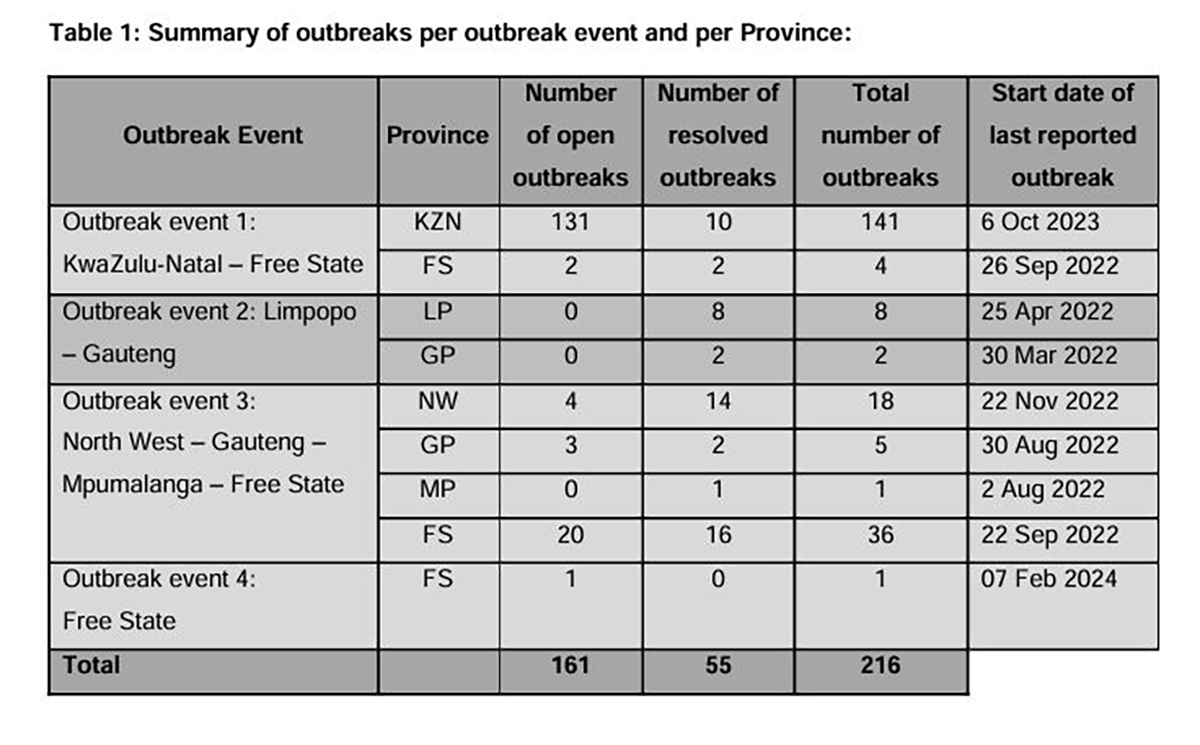
Table showing recent FMD outbreaks in South Africa. (Source: Directorate of Animal Health)
Closer to home, Botswana’s fencing plan is also seen as an indictment of South Africa’s failure to prevent the spread of FMD. Until around 2019, South Africa was viewed as a continental leader in animal disease control measures.
Previously confined to narrow corridors of land along the borders of Zimbabwe and Mozambique, the disease has spread rapidly into six of the country’s nine provinces over the past few years.
Animal health director Dr Mpho Maja says there have been more than 200 FMD outbreaks nationwide since March 2022.
According to Maja’s latest disease status update, 161 outbreaks are still “open”, while 55 have been “closed” with the World Animal Health Organisation.
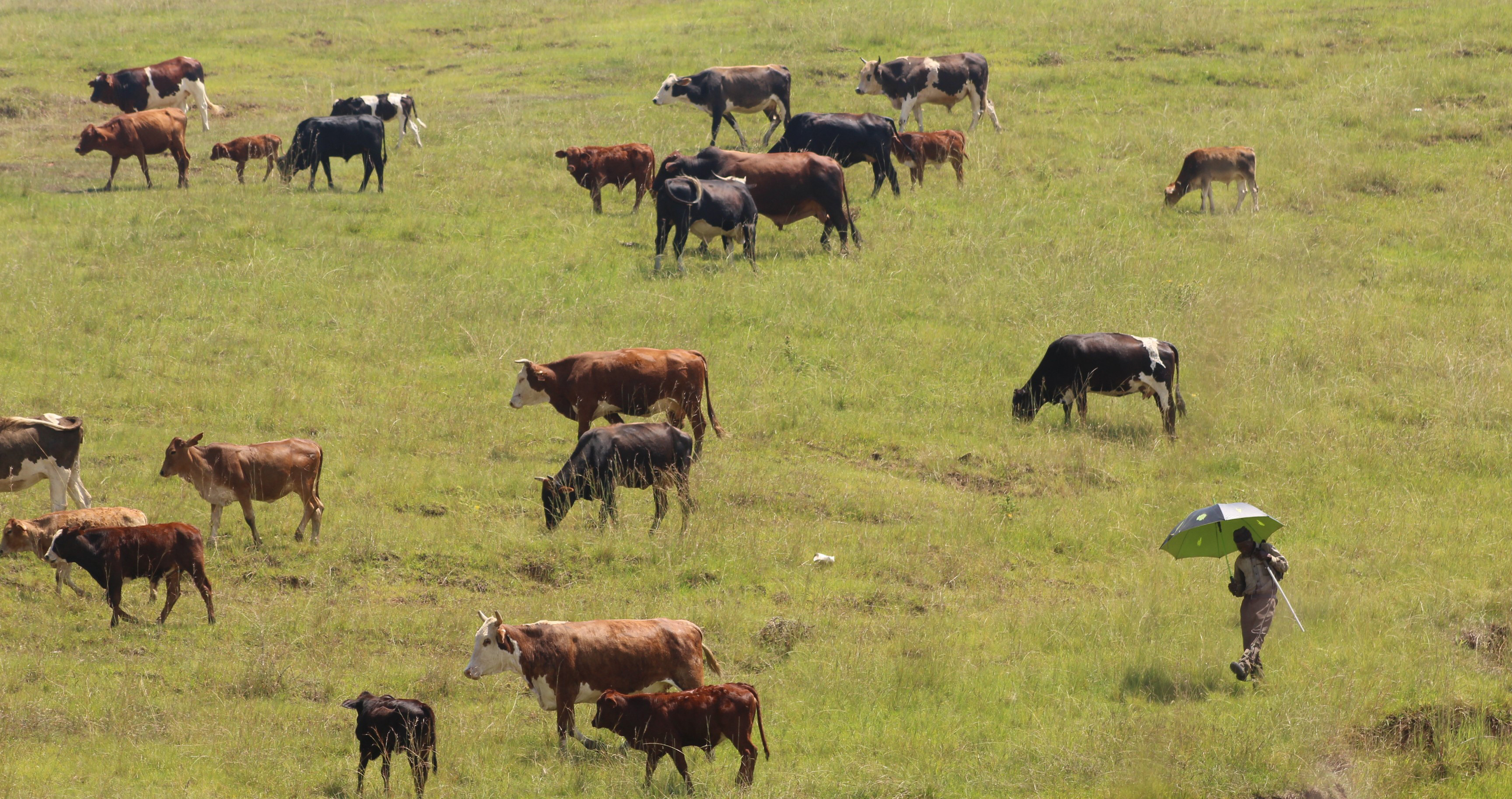
A cattle herder shelters from the sun while tending to his animals in the Bergville district in KwaZulu-Natal, the province with the highest number of Foot and Mouth disease outbreaks. (Photo: Tony Carnie)
More than 130 of the open outbreaks are in KwaZulu-Natal and roughly 20 in the Free State. The most recent outbreak was reported in the Free State in February.
There are now only three provinces that have not been affected by the disease: Eastern Cape, Northern Cape and Western Cape.
A further concern is that domestic cattle are now emerging as a major source of transmission, whereas buffalo and other wildlife species were previously regarded as the main carriers.
In a presentation to Wildlife Ranching SA last year, Dr Livio Heath of the Agricultural Research Council told game ranchers there was now a significant risk of local disease-free buffalo becoming infected by cattle – potentially threatening the wildlife industry.
Daily Maverick has sent questions to the SA Department of Agriculture, Land Reform and Rural Development, the Botswana Ministry of Agriculture, senior Botswana veterinary officials and the SA Red Meat Producers Association. No responses have been received. DM




















 Become an Insider
Become an Insider
“South Africa was viewed as a continental leader in animal disease control measures” And now we are viewed as the laughing stock There are more criminals in Government than the average per capita And no likelihood of that changing in the near future as wrongdoers are censored, suspended for a “holiday” and then promoted
The erection of the fence is a desperate measure. Technically, it is possible to make a fence that blocks animals but not humans. But humans moving across can also carry the virus and cause its spreading. Which is most likely why the need a new fence.
The methods to control FMD are well known and available. Firstly there are vaccines. Next, controls and permits are required for animal movement. The government failed to implement this for many years. South African meat exports to Europe has been banned, while Botswana and Namibia are benefiting. Just another failure of the ANC resulting in huge losses for producers and workers.
The comments by Tony is incorrect, sensational and misleading.
Botswana acted in good faith, responsible and protects the farmers from irresponsible governance.
The fence cannot and will not negatively influence the riverbed as reported.
The fence is 100 meters above the waterline. The Molopo river is mostly dry and flows once in 7 years. There are no waterpoints in the river as the Botswana government provide water points with fresh water for cattle.
The misleading comments that the fence could create an environmental disaster is untrue. The removal of the invasive ,Prosopus trees is a benefit, furthermore there is no damages to the riverine .
You are welcome to visit the area and report on the correct facts, provided you don’t litter while camping